'Jo' Delivery Trip – Cartagena to Las Palmas

|
'Jo' Delivery Trip – Cartagena to Las Palmas
Skipper: George Clitter, Crew: Ian Grieves, Bob Tinley & Richard Truscott.
After a couple of days of preparations, 'Jo' left Cartagena on the morning of 27th Sept under a cloudy sky and with a N F5 breeze. This soon built up to a F7 and a lumpy following sea and we were well reefed prior to sunset. But as always in the Med the wind dropped as quickly as it rose and we were motor sailing before daybreak. We could probably have made Gibraltar by early evening on day 2, despite the adverse current. But as we didn't want to arrive in the dark we headed inshore out of the current, aiming for Estapona marina. This is about 20 miles up the coast from Gibraltar, and we arrived by late afternoon. Next morning, with no wind, we had to motor to Gibraltar, arriving at the fuel berth before noon. Here we filled up the main tank and 10 jerry cans for 60p/litre which was a welcome surprise.

Happy Skipper as we round Europa Point, Gibraltar.
But there was no room at either Ocean Village (Marina Bay) or Queensway marinas so we ended up north of the border in the big but relatively empty marina at La Linea. We understand a new 700 berth marina is planned in Gibraltar so La Linea may be even quieter if that goes ahead.
We then had couple of days of maintenance and some serious shopping for essential British food supplies in Gibraltar at Morrison's. During our stay the wind remained in the E but started to increase into a classic Levanter with cloud streaming west off the top of the 'Rock'. Our schedule had us leaving for Las Palmas on the 1st Oct and the various forecasts were poured over the day before. The local forecast and Navtex were saying F6-7 but MeteoFrance was saying F8. So on the basis that it was downwind (we intended to only use the Genoa), 'it's always windy/lumpy in the Straits with a Levanter blowing' and 'what do the French know anyway' - we left as scheduled at 1000.
Well, MeteoFrance were correct - as we passed Tarifa at 1200 with the genny rolled to under 50%, the wind reached F8 and for several hours it was often over 40 knots (max gust seen was 49 knots). The wind over tide generated an impressive sea with 3-4m waves which saw 'Jo' surfing at around 10 knots at times. But she proved a well mannered lady under such trying conditions. Fortunately visibility remained pretty good and shipping traffic surprisingly light so crossing the shipping lanes was accomplished without too much additional drama. As we edged south we came under the relative shelter of the Moroccan coast and the wind moderated to a F7 by nightfall but the sea still remained very lumpy. Then by midnight it was all over and we had to put the motor on to keep up 6 knots with just a light NE breeze remaining.
For the next 2 days our track was between 40 and 50 miles off the Moroccan coast but the wind remained a stubbornly light NE F2-3. So the motor stayed on to keep up a SOG of 6 knots. But at least it was mostly sunny and starting to get warmer. By noon on the 3rd Oct the NE breeze was picking up a bit and our ETA in Lanzarote allowed us to finally switch off the motor and sail - a reduced SOG of 5 knots would make sure we arrived in daylight.
So we played with the Code zero for a few hours and tried out the new inner forestay and storm jib. By late afternoon, now back under genny, we spotted a whale astern of us (probably a Minke) but it was too quick for a photo. Then a large pod of bottle-nose dolphins arrived to escort us for an hour or so towards Lanzarote – loads of photos taken but only a few came out as they move so quickly!
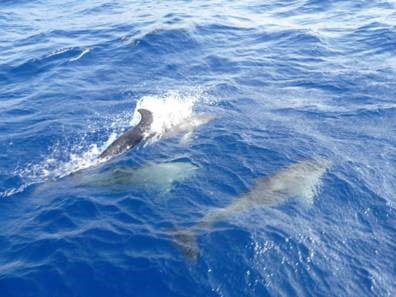
Dolphin escort North of Lanzarote.
The lights of Lanzarote finally showed up before dawn on 4th Oct and we arrived in Puerto Calero at 1000. We were all very impressed by this marina – well run, good facilities and very helpful staff and yard. We even got to stay in the super yacht end of the marina for a couple of days.
Now we were 'almost there', our progress could slow to day sailing mode. Also by this time a star chef, in the shape of Richard, started to emerge from the crew (having recovered from mal de mer suffered en route). So we were all treated to some excellent onboard dining over the remaining days.
After a few days in Puerto Calero we started with a 9 mile hop on to Marina Rubicon on the southern tip of Lanzarote on 9th Oct. This did not get our vote compared to Puerto Calero – much more spread out, with big residential developments either side and it was more expensive. On 10th Oct, we headed 40 miles south to Grand Tarajal in the middle of the east coast of Fuerteventura. We motor-sailed during the morning but the NE breeze picked up later allowing us to play with the big gennaker.
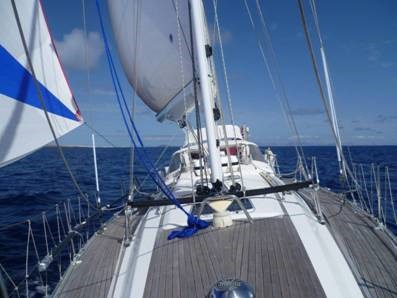
Big Gennaker up en route to Gran Tarajal. Fuerteventura
The marina at Gran Tarajal got a good write up in the RCC pilot book: with good shelter and fairly new pontoons, all proved true. Unfortunately one detail had not changed - the lack of hot water in the showers! The marina is on the south side of the local town which proved to be a surprisingly busy place during our evening stroll.
The next 20 mile hop down the coast on 11th Oct was more in hope than expectation as we had conflicting info about our destination - Morro Jable. As it turned out, the RCC pilot book proved correct as we found no room on the official 'visitors' pontoon (opposite the ferry berth) and the southern half of the harbour was quite shallow with poorly maintained pontoons. So we decided to anchor for the night off the beach to the north of the harbour. This location proved good holding on sand but we had quite a bit of rolling overnight due to surge even though the sea looked flat calm.
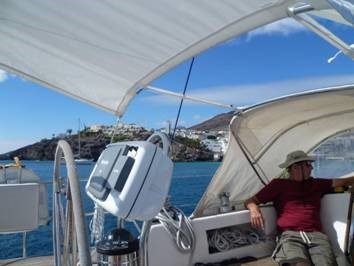
Bob relaxing at anchor off Morro Jable beach
Next day (12th Oct) saw us set off at dawn on our final leg of 60 miles to Las Palmas. Once past the southern tip of Fuerteventura we had our best sail of the trip on a close reach in NNE F5 with speeds of up to 8 knots - though the weather was mostly overcast. The sun came out to greet us as we approached Las Palmas in the afternoon.
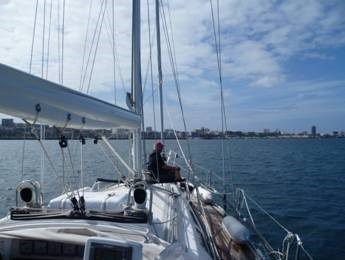
'Jo' approaching Las Palmas
We spent the night on the marina reception pontoon before moving to our allocated berth the next day. Total log mileage for the trip was 1016 miles.We then spent 5 days continuing preparations for the ARC including work up the mast.
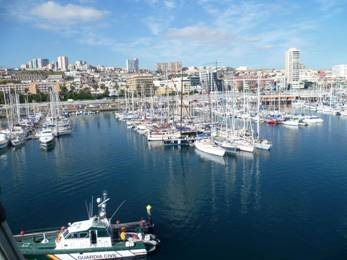
Las Palmas marina from the mast top
But we also found time to get to know our way around a bit of Las Palmas including the very impressive beach front. We returned to the UK on 18th Oct and 'Jo' now awaits the arrival of her ARC crew on 15th Nov.
|